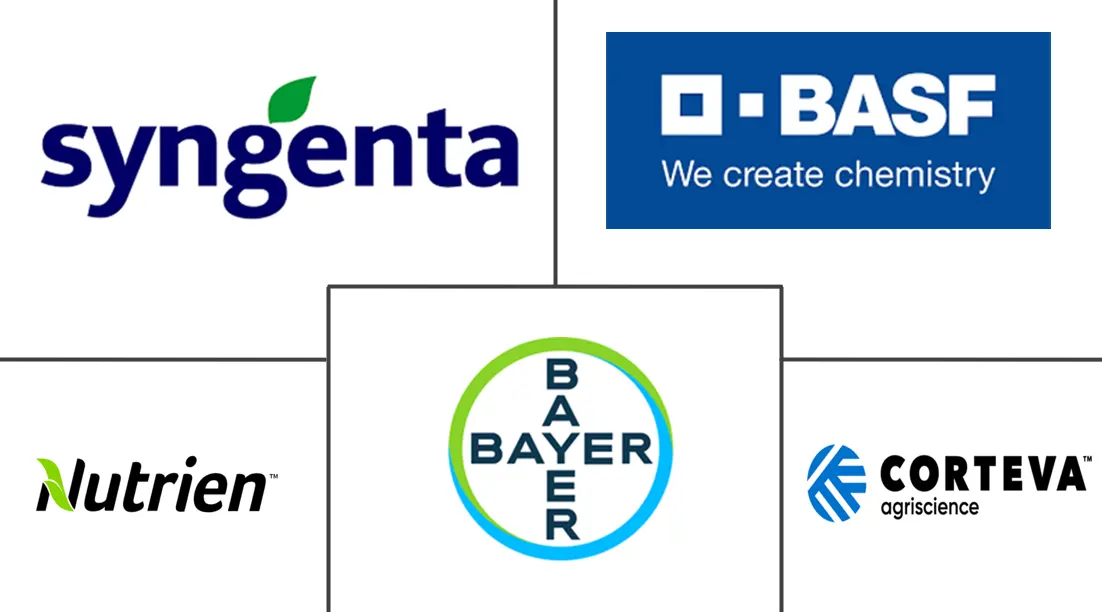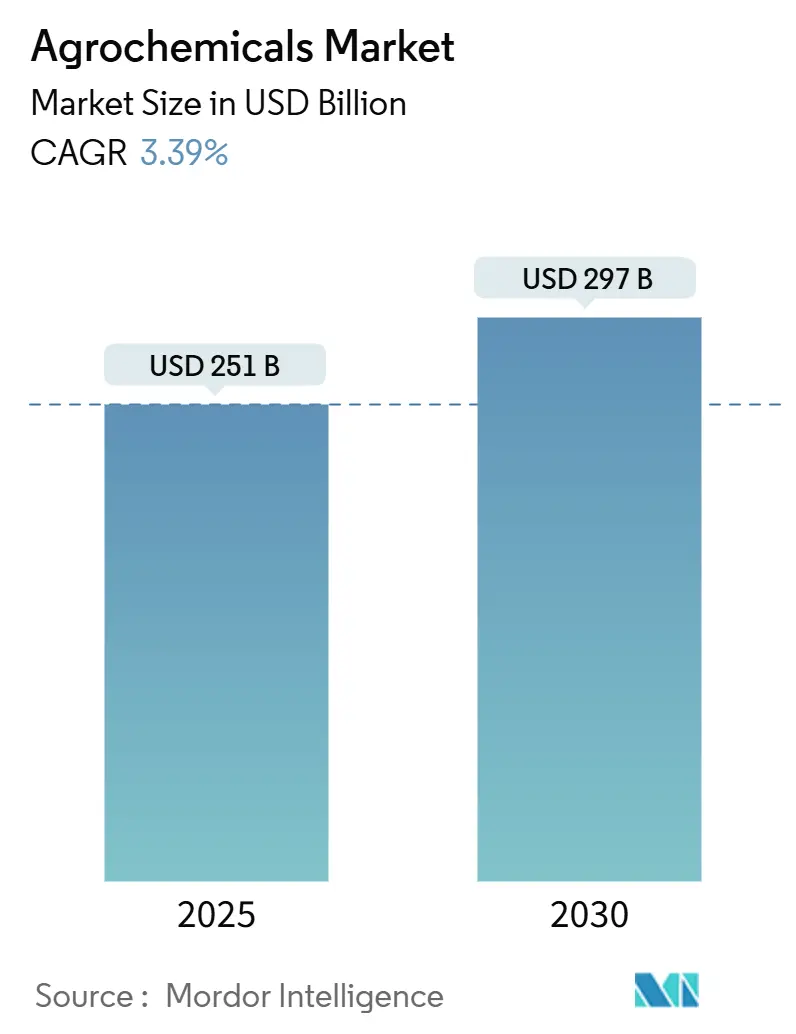
Agrochemicals Market Analysis by Mordor Intelligence
The agrochemicals market reached USD 251 billion in 2025 and is forecast to rise to USD 297 billion by 2030, translating into a steady 3.39% CAGR. Growth is supported by sustained fertilizer demand in large grain economies, rapid penetration of biological crop-protection products, and wider deployment of precision-agriculture tools that lift input-use efficiency. At the same time, the European Union’s Farm to Fork mandate to halve chemical pesticide use by 2030, China’s periodic fertilizer export curbs, and increasingly stringent residue limits in major import markets are forcing producers to accelerate portfolio shifts toward low-toxicity chemistries and digital advisory services. Biologicals are scaling quickly on the back of pesticide-tax regimes now active in 30 countries and streamlined Brazilian and Indian registration pathways, while premium herbicides with novel modes of action address the costly rise of resistant weeds. Competitive intensity is growing as generics erode margins on mature molecules and new “input-as-a-service” models reward outcome-based pricing over product volume, setting the stage for a decade defined by technology integration and sustainability credentials within the agrochemicals market[1]Source: European Commission, “Farm to Fork Strategy,” ec.europa.eu.
Key Report Takeaways
- By product type, fertilizers led with a 46.0% revenue share of the agrochemicals market in 2024, and the biological pesticides are projected to expand at a 14.7% CAGR through 2030.
- By application, crop-based uses held 83.0% of the agrochemicals market share in 2024, while the non-crop category is advancing at a 9.9% CAGR to 2030.
- By geography, Asia-Pacific commanded 48.5% of the agrochemicals market size in 2024; South America posts the fastest CAGR at 4.4% through 2030.
- Syngenta Group, Bayer Crop Science, BASF Agricultural Solutions, Corteva Agriscience, and Nutrien collectively controlled 55.6% of 2024 revenue within the agrochemicals market.
Global Agrochemicals Market Trends and Insights
Drivers Impact Analysis
| Driver | (~) % Impact on CAGR Forecast | Geographic Relevance | Impact Timeline |
|---|---|---|---|
| Escalating Herbicide-Resistant Weeds Spur Premium Herbicide Demand | +0.8% | Global, strongest in North America and South America | Medium term (2-4 years) |
| Convergence of AI-Enabled Input-as-a-Service Business Models | +0.6% | North America and Europe, expanding to Asia-Pacific | Long term (≥4 years) |
| Surge in Biologicals Pushed by Pesticide-Tax Regimes | +0.9% | Europe is leading, spreading to Asia-Pacific, and South America | Medium term (2-4 years) |
| Carbon-Credit Monetization of Nitrogen-Efficiency Products | +0.4% | North America and Europe, pilots in Brazil | Long term (≥4 years) |
| Mainstream Expansion of Controlled-Release Fertilizers | +0.5% | Global, led by Asia-Pacific and North America | Medium term (2-4 years) |
| Crop Diversification in Vertical and Indoor Farms | +0.3% | Urban centers globally, concentrated in developed markets | Long term (≥4 years) |
| Source: Mordor Intelligence | |||
Escalating Herbicide-Resistant Weeds Spur Premium Herbicide Demand
Herbicide-resistant weeds now infest more than 270 million acres worldwide, pushing growers toward premium actives that deliver novel modes of action. FMC’s Dodhylex active, the first new herbicide mode in three decades, secured its inaugural registration in Peru and targets resistant grass weeds in rice, with a commercial launch slated for August 2025. The United States Environmental Protection Agency’s 2024 resistance-management framework reinforces integrated weed-management protocols, giving regulatory support to innovative formulations. Sumitomo Chemical’s Rapidicil registration in Argentina underpins the competitive race to serve no-till systems, aiming for JPY 100 billion (USD 0.65 billion) in annual sales from conservation-tillage herbicides. Growers' willingness to pay remains strong because resistant weeds impose yearly global yield losses above USD 15 billion.
Convergence of AI-Enabled Input-as-a-Service Business Models
Digital farming platforms are displacing traditional product-only distribution by bundling agronomic advice, variable-rate prescriptions, and outcome-based guarantees. Bayer’s CROPWISE platform now integrates field sensors, weather data, and satellite imagery to fine-tune spraying and fertilizing schedules. BASF and Agmatix apply machine-learning diagnostics to detect soybean cyst nematode stress before visual symptoms appear, protecting yields while cutting chemical load. Syngenta’s tie-up with Taranis equips retailers with AI-powered scouting to drive precise input placement, converting one-time sales into subscription revenue. These services reduce chemical intensity per acre by up to 20%, aligning profitability with sustainability imperatives in the agrochemicals market.
Surge in Biologicals Pushed by Pesticide-Tax Regimes
Pesticide levies ranging from EUR 1.50 to EUR 70 per kilogram (USD 1.6 – USD 75) across 30 countries are redirecting demand toward lower-risk biologicals[2]Source: World Resources Institute, “Denmark Climate-Smart Agriculture Policy,” wri.org. Denmark’s climate-smart agriculture package and Brazil’s National Bio-inputs Program have streamlined approvals, propelling the Brazilian biologicals market to BRL 5 billion (USD 1 billion) in 2024 sales with 15% annual growth. India fast-tracked registrations for Trichoderma and Beauveria actives, enlarging grower access to indigenous microbial solutions. Syngenta’s collaboration with Provivi on pheromone-based pest disruption in Asian rice and maize adds further momentum.
Carbon-Credit Monetization of Nitrogen-Efficiency Products
Producers are coupling controlled-release or microbial nitrogen solutions with voluntary carbon programs that pay growers for lower greenhouse gas emissions. Pivot Bio’s N-OVATOR framework rewards farmers with tradable credits for replacing synthetic urea, providing an incremental revenue stream per acre that offsets the price premium on biological nitrogen. Bayer’s India carbon initiative links smallholders to global offset buyers, deepening loyalty to the company’s fertilizer repertoire. Polymer-coated fertilizers cut volatilization losses by 20-30%, delivering both yield stability and carbon monetization potential.
Restraints Impact Analysis
| Restraint | (~) % Impact on CAGR Forecast | Geographic Relevance | Impact Timeline |
|---|---|---|---|
| Accelerating Phase-Outs of High-Toxicity Actives in EU, Brazil, and China | -0.7% | Europe, Brazil, China | Short term (≤2 years) |
| Volatile Glyphosate Pricing Squeezes Formulator Margins | -0.5% | Global, high for generics | Short term (≤2 years) |
| Rising Regulatory Data-Package Costs | -0.4% | Global, heaviest in developed markets | Medium term (2-4 years) |
| Chronic Activist Litigation Risk in North America | -0.3% | North America, global spillover | Long term (≥4 years) |
| Source: Mordor Intelligence | |||
Accelerating Phase-Outs of High-Toxicity Actives in EU, Brazil, and China
Regulators are shortening grace periods for active ingredients flagged for toxicity, forcing manufacturers to write off inventory and accelerate reformulation pipelines. The European Union’s latest proposal eliminates certain organophosphates from sensitive habitats, while Brazil aligns approval criteria with the EU, removing nearly 200 legacy molecules by 2026[3]Source: European Commission, “Farm to Fork Strategy,” ec.europa.eu. BASF shuttered its glufosinate plant in 2024, booking impairment charges linked to the tighter regulatory outlook. Chinese policies prioritize low-toxicity fungicides and biopesticides, expecting commercial volumes of 90,000 metric tons by 2025.
Volatile Glyphosate Pricing Squeezes Formulator Margins
Spot glyphosate prices swung between USD 2.90 and USD 5.90 per kilogram during 2024, eroding working capital for formulators who cannot hedge effectively. Bayer’s exploration of strategic alternatives for glyphosate assets underscores reputational and litigation pressures that threaten future supply stability. Export curbs and power shortages in China, which supplies over 60% of technical material, amplify volatility that propagates through the agrochemicals market.
Segment Analysis
By Product Type: Biologicals Advance Even as Fertilizers Dominate
Fertilizers accounted for 46.0% of 2024 revenue inside the agrochemicals market, reflecting their indispensable role in macronutrient delivery to grains and oilseeds. Yet volatile natural gas prices inflated ammonia costs, squeezing margins for nitrogen producers and signaling a pivot toward efficiency technologies such as urease inhibitors and controlled-release coatings that reduce application rates by 15-25% without yield loss. The agrochemicals market size for fertilizers is forecast to expand at just 2.3% CAGR, slower than the overall market because of plateauing application rates in developed economies. Producers, therefore, emphasize premium polymer-coated lines and carbon-credit-linked offerings that capture value beyond volume.
The biological segment, encompassing microbials, botanicals, pheromones, and biochemicals, grew 14.7% in 2024 and is projected to reach USD 25 billion by 2030. Within that total, the agrochemicals market size for bio-insecticides is on track to advance at 15.2% CAGR, buoyed by European residue-limit tightening and Brazilian fast-track registrations. As a result, integrated pest-management programs now mix chemical and biological tools in single-season rotations, enabling suppliers to cross-sell proprietary strains and adjuvants. Major players such as Syngenta Biologicals and FMC pivot aggressively toward this space, accelerating mergers and acquisitions to fill portfolio gaps. Herbicides, fungicides, adjuvants, and plant growth regulators remain critical; and their combined share of the agrochemicals market is projected to decline slightly as biologicals cannibalize volume while fetching higher margins.
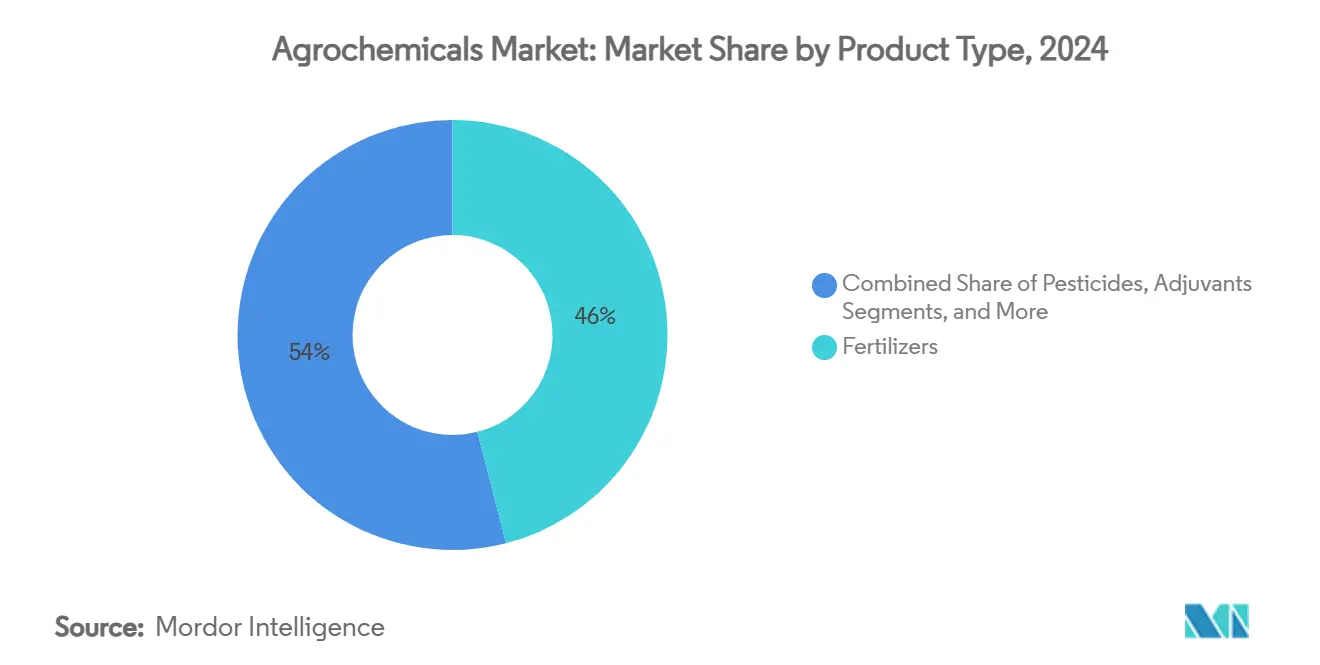
Note: Segment shares of all individual segments available upon report purchase
By Application: Vertical Farming Accelerates Non-Crop Uptake
Crop applications, grains, cereals, pulses, oilseeds, fruit, and vegetables captured 83.0% of revenue in 2024. The segment benefits from robust soybean and corn acreage in Brazil and the United States, together representing more than 40% of global production. Soybean output alone is projected to rise to 235 million metric tons by 2040, entrenching nitrogen-fixing inoculants and pre-emergence herbicides as staples. In China, an additional 50 million metric tons of grain output is targeted by 2030, elevating demand for nutrient-use efficiency products. The agrochemicals market share for crop applications is projected to edge lower to 80.5% by 2030 as indoor farming expands, but it still contributes more than three-quarters of future volume.
Non-crop uses, turf, ornamentals, and controlled-environment agriculture form a smaller base yet show a 9.9% CAGR through 2030, outpacing traditional agriculture. Vertical farms deliver leafy greens at yields up to 20-fold higher per acre while utilizing sensor-driven fertigation, creating a premium niche for water-soluble specialty fertilizers and biological foliar sprays. Smart-city development projects in the Middle East and Southeast Asia increasingly feature rooftop or container farms, diversifying geographic exposure. Consequently, suppliers develop nutrient packs tailored to hydroponic conductivity and pH parameters, a capability that differentiates technology-enabled incumbents in the agrochemicals market.
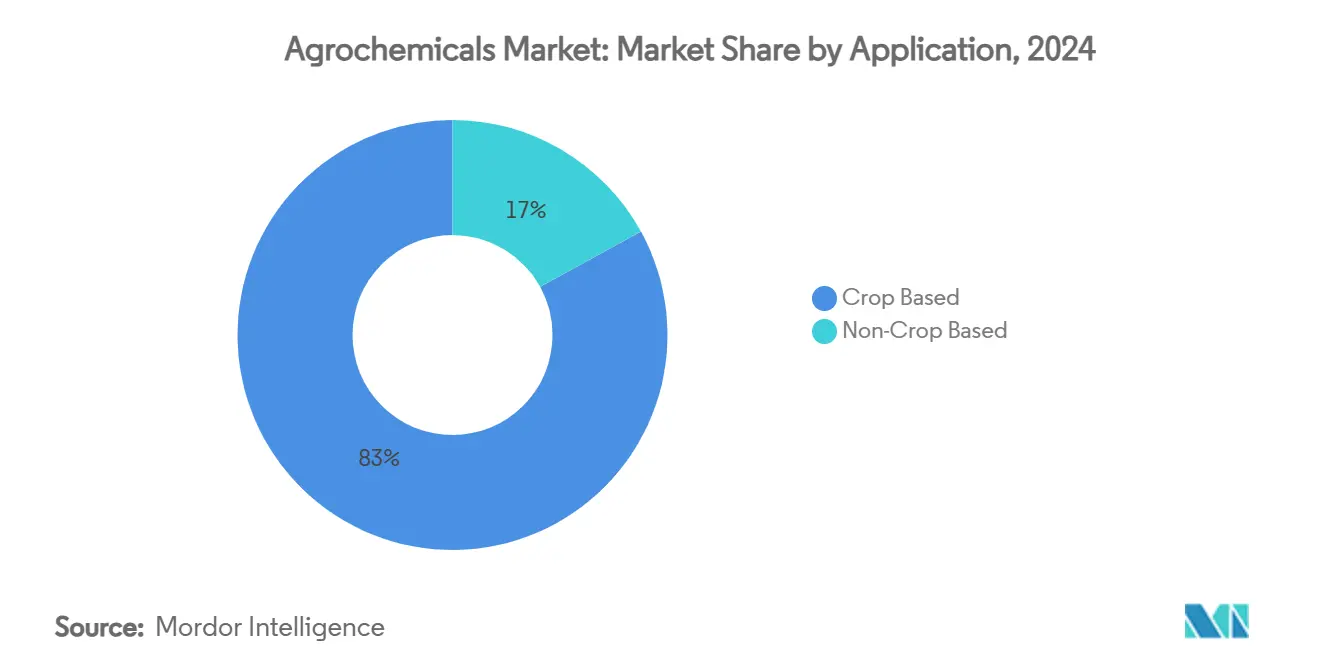
Geography Analysis
Asia-Pacific retained the highest regional revenue in 2024, accounting for 48.5% within the agrochemicals market, supported by intensive cultivation across China and India. China manufactures 50% of the worldwide active-ingredient output, yet domestic environmental rules now favor low-toxicity lines, stimulating investment in biopesticide capacity. India’s contract development and manufacturing organizations secure multiyear deals that fill Western pipeline gaps, driving double-digit revenue growth. Japan accelerates the adoption of controlled-release fertilizers to meet emission targets, the Australia balances fertilizer demand with climate-induced drought adjustments. Government subsidy programs promoting digital soil testing and balanced nutrition enhance baseline consumption patterns.
South America is the fastest-growing territory, expanding by 4.4% CAGR through 2030. Brazil’s biological market hit BRL 5 billion (USD 1 billion) in 2024, with uptake concentrated in soybean and cotton. Logistics bottlenecks persist; 62% of Brazilian agricultural roads are below optimal quality, raising costs and encouraging localized formulation plants. Argentina’s no-till acreage exceeds 90%, underpinning demand for residue-compatible herbicides such as Rapidicil. Climate volatility, especially drought, boosts micronutrient and water-efficiency product sales, shaping a resilient business case for adaptive technologies within the agrochemicals market.
North America and Europe, though mature, remain innovation hubs. The United States contends with tariff proposals on Canadian potash that could raise farmer costs by USD 100 per ton, prompting interest in biological nitrogen replacement and potassium-solubilizing microbes. Canada promotes 4R nutrient-stewardship certification, linking lender incentives to fertilizer best practices. Europe’s Farm to Fork strategy mandates 50% pesticide cuts by 2030, triggering accelerated biological approvals and digital traceability systems. The Middle East and Africa grew 3.4% and 4.1%, respectively, propelled by sovereign food-security investments, hydroponic adoption, and reclaimed desert farming, albeit from smaller bases. Collectively, these dynamics keep the agrochemicals market on a path of gradual volume growth complemented by higher-value product substitution.
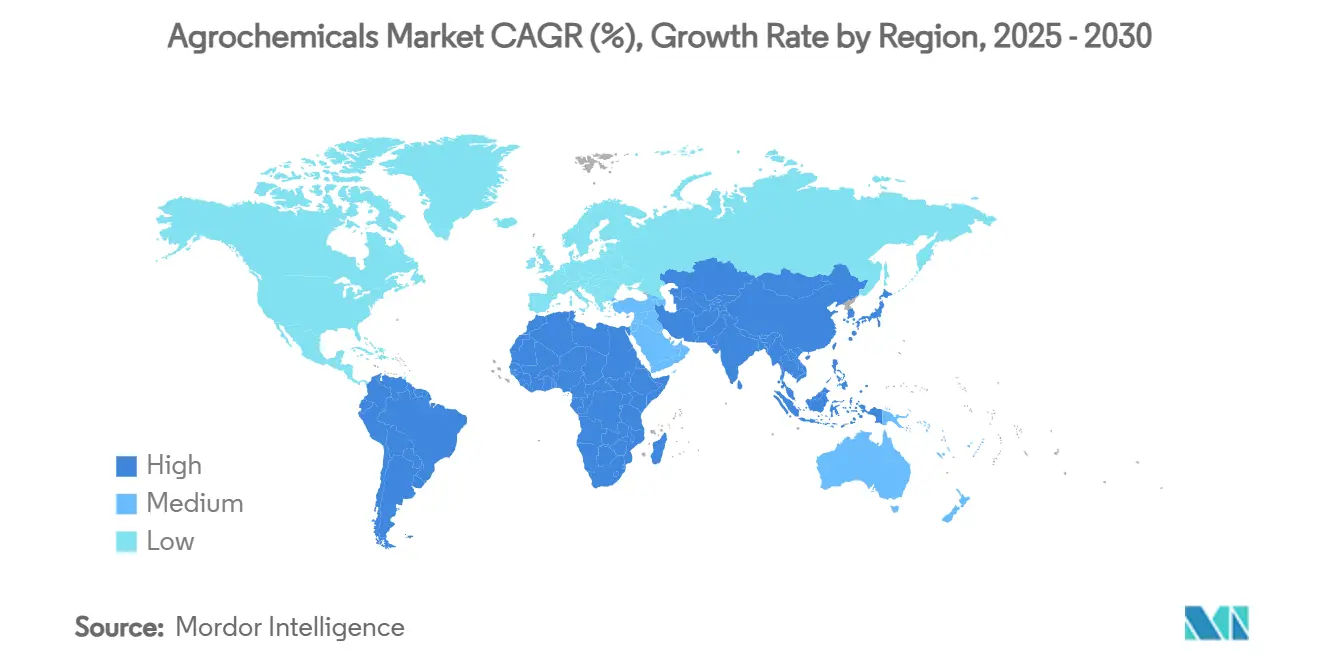
Competitive Landscape
Moderate concentration defines the agrochemicals market: the top five suppliers commanded 55.6% of 2024 revenue. Syngenta Group led with 14.5%, yet its 2024 sales slipped 10% to USD 28.8 billion amid channel destocking and adverse weather. Bayer Crop Science followed at 13.0%, while BASF Agricultural Solutions, Corteva Agriscience, and Nutrien rounded out the group. All five allocate 7-10% of sales to research & development, focusing on biologicals and digital platforms to defend their share from generic competition. BASF’s filing for a heteroaryl insecticide (EP 4389210 A1) shows continued synthetic chemistry innovation alongside biological workstreams[4]Source: European Patent Office, “EP 4389210 A1 – Heteroaryl Compounds for Controlling Invertebrate Pests,” epo.org.
Emerging specialists challenge incumbents. RovensaNext concentrates solely on biologicals, leveraging rapid field-trial data to secure local approvals ahead of larger rivals. Indian and Chinese producers expand off-patent portfolios, capitalizing on cost advantages to win tenders in Africa and Southeast Asia. To protect margins, multinationals pursue outcome-based pricing and bundled digital services, illustrated by Corteva’s 2025 partnership with NEVONEX that merges in-cab software with proprietary actives for variable-rate spraying.
Strategic transactions reshape the landscape. Syngenta divested its FarMore seed-treatment platform to Gowan to streamline focus, while BASF joined forces with Agmatix for AI nematode diagnostics. Sumitomo Chemical acquired Romanian distributor Naturevo, widening its European footprint in specialty fertilizers. Mergers and Acquisitions intensity is highest in biologicals, where technology diversification is imperative to meet regulatory trajectories. The competitive race will ultimately reward those who align digital agronomy, sustainable chemistries, and reliable supply within the evolving the agrochemicals market.
Agrochemicals Industry Leaders
-
Syngenta Group
-
Bayer Crop Science AG
-
BASF Agricultural Solutions
-
Corteva Agriscience
-
Nutrien Ltd
- *Disclaimer: Major Players sorted in no particular order
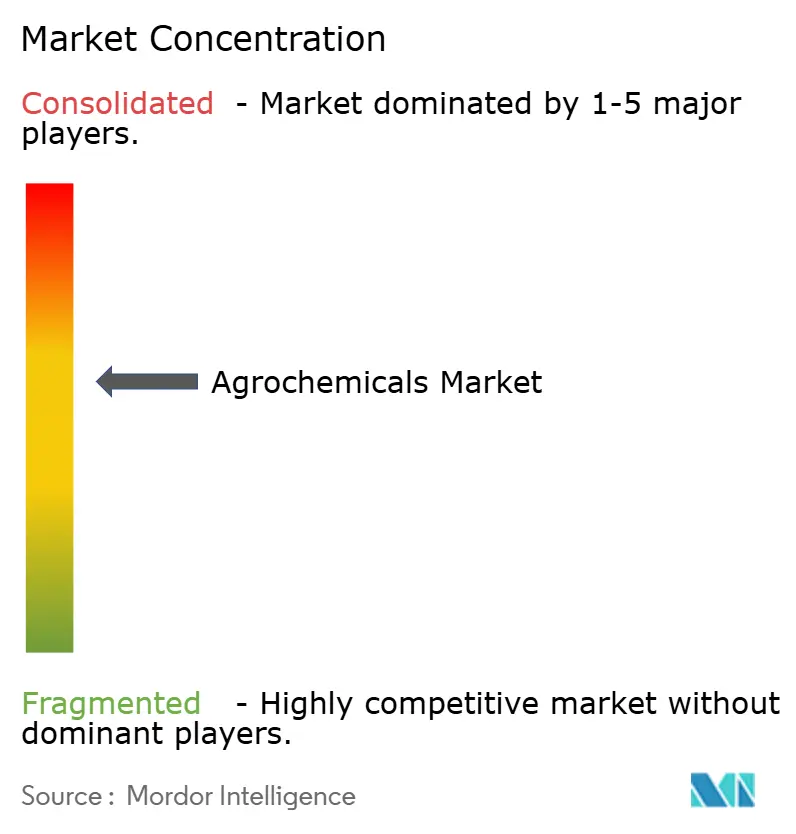
Recent Industry Developments
- May 2025: Corteva Agriscience and NEVONEX launched a collaboration to deliver digitally enabled crop-protection prescriptions that integrate on-farm data analytics.
- April 2025: FMC Corporation gained its first commercial registration for Dodhylex in Peru, targeting resistant grassy weeds with commercial sales projected by August 2025.
- March 2025: FMC and Bayer agreed to co-commercialize Isoflex herbicide technology in Europe, with regulatory approval anticipated during 2025.
- March 2025: Syngenta Group reported 2024 revenue of USD 28.8 billion and highlighted strong uptake for PLINAZOLIN and ADEPIDYN platforms despite weather-related headwinds.
Research Methodology Framework and Report Scope
Market Definitions and Key Coverage
According to Mordor Intelligence, the agrochemicals market comprises all factory-made fertilizers, synthetic and biological crop-protection chemicals, adjuvants, and plant-growth regulators that are traded through commercial channels for field and protected agriculture. Usage in forestry and home gardening is included only when the products and pack sizes mirror farm-grade specifications.
Scope exclusion: The study omits on-farm nutrient blends mixed by growers, biotech seed traits, and application machinery.
Segmentation Overview
- By Product Type
- Fertilizers
- Nitrogenous
- Phosphatic
- Potassic
- Pesticides
- Herbicides
- Insecticides
- Fungicides
- Bio-pesticides
- Adjuvants
- Plant Growth Regulators
- Fertilizers
- By Application
- Crop-based
- Grains and Cereals
- Pulses and Oilseeds
- Fruits and Vegetables
- Non-crop-based
- Turf and Ornamental Grass
- Other Non-crop-based
- Crop-based
- By Geography
- North America
- United States
- Canada
- Mexico
- Rest of North America
- Europe
- Germany
- France
- United Kingdom
- Italy
- Spain
- Russia
- Rest of Europe
- Asia-Pacific
- China
- India
- Japan
- Australia
- Rest of Asia-Pacific
- South America
- Brazil
- Argentina
- Rest of South America
- Middle East
- Saudi Arabia
- United Arab Emirates
- Rest of Middle East
- Africa
- South Africa
- Egypt
- Rest of Africa
- North America
Detailed Research Methodology and Data Validation
Primary Research
Structured interviews with agronomists, farm input distributors, regional regulators, and procurement heads across Asia-Pacific, the Americas, Europe, and Africa clarified adoption rates of enhanced efficiency fertilizers, average selling prices, and the likely phase-out timeline of high toxicity actives, thereby anchoring desk findings.
Desk Research
Our analysts started with publicly available macro and trade indicators from tier-1 bodies such as FAO, OECD-FAOSTAT, UN Comtrade, USDA ERS, and Eurostat, complemented by annual reports and 10-Ks of major input suppliers. Price curves and company financials were cross-verified with D&B Hoovers and Dow Jones Factiva. Specialist datasets, WSTS for active ingredient capacity signals and Volza for shipment level pesticide flows, helped fine-tune regional splits. This list is illustrative; many additional sources were reviewed to validate trends and fill gaps.
Market-Sizing & Forecasting
The model begins with a top-down reconstruction of demand using country-level fertilizer application rates (kg/ha), FAO pesticide use statistics, and cropped area forecasts; volumes are then multiplied by blended ASPs collected from trade data. Select bottom-up checks, supplier revenue roll-ups and dealer channel audits, catch anomalies. Key variables include urea spot prices, corn-soy acreage switches, pesticide maximum residue limit revisions, and biologicals' penetration. A multivariate regression with lagged rainfall normals and farm income indices projects consumption to 2030; scenario analysis adjusts for regulatory shocks. Gaps in bottom-up inputs are bridged by regional proxy ratios tested during expert calls.
Data Validation & Update Cycle
Outputs move through variance checks, senior analyst peer review, and a final reconciliation against independent trade and price indices. The dashboard refreshes annually, with interim updates when material events, such as an EU active ban, alter demand.
Why Mordor's Agrochemicals Baseline Commands Reliability
Published figures often vary because providers select different product baskets, pricing points, and update cadences.
We acknowledge these disparities upfront.
Benchmark comparison
| Market Size | Anonymized source | Primary gap driver |
|---|---|---|
| USD 251 B (2025) | Mordor Intelligence | - |
| USD 235.2 B (2023) | Global Consultancy A | Excludes plant growth regulators; uses 2022 average prices; update cycle biennial |
| USD 285.1 B (2024) | Global Consultancy B | Includes pesticide formulation services revenue; constant 2020 dollars without FX adjustment |
| USD 287.9 B (2024) | Industry Analyst C | Counts antibiotic feed additives; mixes wholesale and retail price points |
In sum, Mordor's disciplined scope, annual refresh, and dual validation steps deliver a balanced, transparent market baseline that decision makers can trace back to clear variables and reproducible calculations.
Key Questions Answered in the Report
What is the projected value of the agrochemicals market by 2030?
The market is projected to reach USD 297 billion by 2030, growing at a 3.39% CAGR.
Which product category is expanding fastest?
Biological pesticides lead with a forecast of 14.7% CAGR thanks to regulatory support and farmer adoption of integrated pest-management programs.
Why are controlled-release fertilizers gaining traction?
They reduce nutrient losses by up to 30% and often qualify for carbon-credit programs, improving both environmental and economic performance.
Which region is growing the quickest?
South America posts the fastest CAGR at 4.4%, driven by Brazil’s large-scale adoption of biologicals and expanding crop acreage.
How concentrated is the competitive landscape?
The top five players control around 55.6% of revenue, signaling moderate concentration with significant scope for challengers.
What digital trends are influencing agrochemicals?
Input-as-a-service models that pair AI analytics with variable-rate applications are lowering chemical volumes while opening recurring revenue streams.
Page last updated on:
